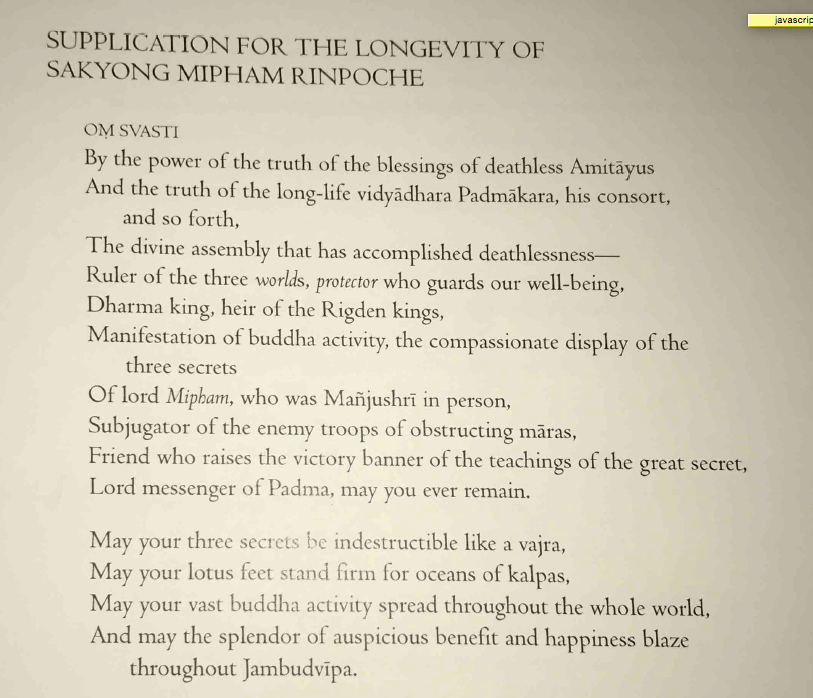
The Challenges of Responding to Abuse at Shambhala: A Discussion with Susan Piver
July 12, 2018
Shrine of Devotion, Betrayal, or Indoctrination? An Internal Shambhala Email, Annotated
July 16, 2018
It identifies Mukpo as both the reincarnation of a Tibetan saint and a meditational deity. It says that he is a king, a ruler of the “three worlds” (of desire, form, and formlessness), and the “manifestation of buddha activity.” The chanter prays for Mukpa’s influence to spread through Jambudvipa, which basically means “earth”, but from the perspective of deities who can perceive multiple worlds.
According to members I’ve spoken with, this chant is deployed to two contexts. At some Shambhala centres, entry-level members are introduced to it at weekly gatherings. When they ask about the chant’s meanings or express discomfort at praying to human being as if he were a deity, they are typically told that they can understand it “symbolically” for now, and that deeper meanings will be unfolded at higher levels of commitment.
The second usage of the change comes at those higher levels, where, along with explication, the chant itself becomes an expression of “samaya”.
“Samaya” is a “contract” to a teacher made in Tantric streams of Indian wisdom culture. Breaking it, which can happen through as little as thinking badly about that teacher, is said to result in endless cycles of disgusting and horrific torture in “hell-realms”. Over the years I have received communications from members of neo-Tibetan tantric groups who say that this is a source of literal terror for them.
I don’t think it matters that much that the literal meanings of these threats might be lost on postmodern practitioners. When I had “samaya” with Michael Roach and his teacher, the late Khenpo Rinpoche, I took the gory details as metaphors for inescapable psychological pain.
Many traditionalists would say that a text used for Tantric practitioners is actually forbidden to those who are not initiated. In other words, it would be “illegal” for students who had not attained a certain maturity in relation to the teaching content to be asked to read ritual literature “symbolically”. Amongst all of the ways in which the followers of Chögyam Trungpa Rinpoche have, like him, both appealed to “tradition” while holding it in contempt, what would this one be about?
A commenter on my Facebook feed wrote about how he was asked to hold the meaning of the chant symbolically as a new student. He remarks:
“Sadly it turns out that this soft-symbolic, “Don’t worry about it’, ‘You are your own meditation instructor'”, guidance on the chants is actually a bait and switch for those who enter the Vajrayana path, which I fortunately never did.”
The commenter’s observations describe a well-known feature of cult media.
The two performance levels — intro and advanced — allow this same chant to perform the dual functions of propaganda and indoctrination described by Alexandra Stein (via Hannah Arendt) employed by cultic organizations. She explains the difference here. My argument is that the intro-level chant, explained to newcomers as symbolic, works as propaganda. The advanced application, with its more literal implications and commitments, functions to deepen indoctrination.
“Propaganda is not indoctrination, though it may be the first step towards entering a process of indoctrination. Indoctrination is what happens during the subsequent process of brainwashing within an isolated context. Importantly, those to whom propaganda is directed are not yet isolated or are only partially so. They still have some points of reference in the outside world. They may still have friends or family or colleagues with whom they can check out their impressions. The much more intense process of indoctrination to extreme beliefs occurs when the new recruit has been successfully separated from their external contacts. Then they can begin to be broken down, to lose their own sense of reality, their own common sense, and they can eventually be pressured to take on new and often dangerous or damaging ideas and behaviors. This part of the process can sometimes take years. Propaganda can be seen as the softening up process that gets the recruit to the point where indoctrination processes can start to be implemented. Propaganda must be believable enough, must have some kind of hook into the real world so that potential recruits will follow the thread and not simply be repulsed immediately.” (2017, 53-54)
According to this schema, it would be worth investigating the relationship between popular Shambhala-based books and media content and the ritual literature of the inner core. The books on the Shambhala Publications back list, for example, might function as a “transmission belt” (again, after Arendt) towards the inner core and its high demands.
I don’t know how many people have “samaya” with Ösel Mukpo, but there are at least 200 gathering on the 15th at the Shambhala Mountain Centre. (More on this in this earlier post.)
Emails to registrants confirm that Mukpo won’t be there, and suggest that the retreat leaders will be attempting to “separate the teacher from the teachings”. In the case of this upcoming “Garchen”, those teachings are said to have been mystically revealed to Mukpo’s father in the early 1980s, and now Mukpo himself.
But this chant, in which devotion and metaphysics are inextricable, makes it clear just how difficult separating the teacher from the teachings actually is in this and other communities governed by modern appropriations of “samaya”. Devotion is the content. The medium is the message.
Reformers who really want to work towards student empowerment and safety have to not only insist upon the physical and administrative withdrawal of an abusive leader, but re-imagine a curriculum somehow separate from its origin story. The content didn’t come from outer space.
The manual from which this is taken ends with the statement: “This material is available in limited publication, and no general publication is made or intended. No part of this material may be reproduced or published in any form without the written consent of the Nalanda Translation Committee.”
Here it is anyway, because transparency, right? It’s important for everyone in yoga and Buddhist communities, which are so susceptible to mechanisms of undue influence, to see how hidden materials of indoctrination work.
Also, no author gets to establish the “intention” of a text as somehow separate from the way it is read, or its various impacts. That goes for me as well, which is something I contemplate as I continue to cover this subject.